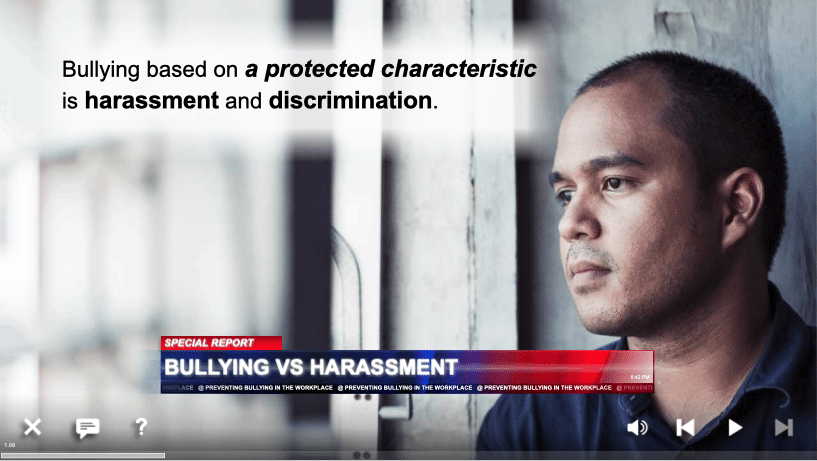Preventing Bullying in the Workplace
Bullying affects workforce health, psychological safety, and productivity. Lead your employees in making the right decisions at the right moments to stop bullying and create a welcoming space.
Course description
This 20-minute course for employees and managers explains what behaviors are considered bullying, the difference between bullying and harassment, and actions that individuals and organizations can take to stop it, including bystander intervention techniques. A video host, on-the-street interviews, interactive exercises and viewer email and tweets raise awareness of different forms of bullying and address common questions.
ONLINE TRAINING
Preventing Bullying in the Workplace

The course covers these topics and more:
- What is workplace bullying?
- Examples of bullying behavior
- Differences between bullying and harassment
- The negative impact of bullying on individuals and organizations
- Role of employers, targets and bystanders
- Bystander intervention strategies to help stop bullying
KEY FEATURES
Why you'll love our training
It’s time to embrace a new era of online training with a valued partner who will ensure seamless implementation, along with a learning experience your employees will truly enjoy.
Course administration
Traliant makes it simple to roll out training to your workplace and provide technical support directly to your employees at no additional cost.
Course customizations
Tailor courses to include your logo, relevant policies, workplace images, and more. Traliant can even customize the course with scenarios that take place in your own workplace environment.
Translations
Training is available in English, Spanish and is supported in over 100 languages.
What to consider when choosing the most effective preventing bullying in the workplace training

- Create a safer and more respectful workplace: Bullying can have a devastating impact on the mental and emotional well-being of employees. Training helps to create a workplace where everyone feels safe and respected.
- Reduce the risk of lawsuits and legal issues: While bullying is not currently prohibited by federal law, many states have introduced anti-bullying legislation. Training helps organizations to comply with state laws and to reduce the risk of lawsuits.
- Enhance employee morale and productivity: Bullying can lead to reduced employee morale, decreased productivity, and increased absenteeism. Training helps to create a more positive work environment that supports employee well-being.
- Empower employees: Training provides employees with the knowledge and skills they need to recognize and respond to bullying.
- Strengthen your organization's commitment to a safe and respectful workplace: Training demonstrates the company's commitment to creating a workplace free from bullying.
- Reduce the risk of employee turnover: Bullying is a major contributing factor to employee turnover.
- Intent to harm: The bully's actions are intended to cause harm or distress to the target.
- Power imbalance: The bully often has more power or authority than the target.
- Repeated behavior: Bullying behaviors occur repeatedly over time.
- Verbal abuse: Yelling, screaming, or using insults or threats.
- Threatening behavior: Making threats to harm or to damage the target's reputation or career.
- Intimidation: Using gestures, facial expressions, or body language to intimidate or threaten the target.
- Social isolation: Excluding the target from meetings, conversations, or social events.
- Cyberbullying: Using emails, text messages, social media, or other electronic means to harass or intimidate the target.
- Harassment: Harassment is often illegal, as it is typically based on a protected characteristic, such as race, gender, religion, or sexual orientation.
- Bullying: Bullying is not necessarily illegal. However, bullying that is based on a protected characteristic can be considered harassment.
- Recognizing bullying behaviors: Understand what behaviors are considered bullying and be aware of the signs of bullying in the workplace.
- Standing up for others: Don’t stand by and watch when you see someone being bullied.
- Reporting bullying: Report bullying behaviors to the appropriate authority, such as a supervisor, HR, or the company's ethics hotline.





